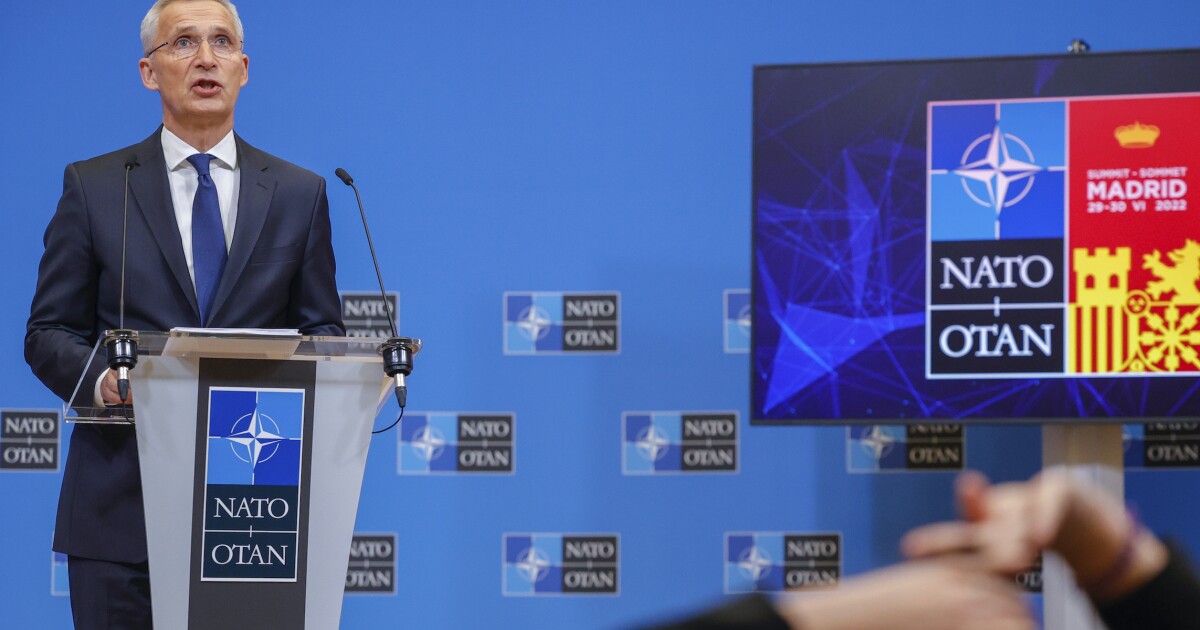

A restriction on railway shipments from mainland Russia across Lithuania has put a harsh spotlight on a dangerous boundary between NATO and Russia.
“We have more than 40,000 troops under direct NATO command, most of them in the eastern part of the alliance and many of them in the Baltic region,” NATO Secretary-General Jens Stoltenberg said Monday. “The purpose of this increased presence is to send a message that we are ready to protect and defend every inch of allied territory, including of course Lithuania and the other Baltic countries.”
Stoltenberg issued that reminder amid an unfolding controversy over Lithuania’s announcement that Russia would not be permitted to ship certain commodities, such as cement, across Lithuania rail lines to Kaliningrad. That restriction, imposed under the auspices of European Union sanctions, was met by a flurry of cyberattacks and Russian state media broadcasts that Russian President Vladimir Putin could initiate a war of conquest against Lithuania.
RUSSIA TO PLACE NUCLEAR-CAPABLE MISSILES IN BELARUS
“We understand perfectly well that when the [Russia] armed forces achieve the goals set by the president and reach the western border of Ukraine, the rest will certainly not be about Ukraine,” Russian lawmaker Andrey Gurulyov said this weekend in a state media broadcast translated by the Russian Media Monitor’s Julia Davis. “Yes, the taming of Lithuania is being considered.”
Gurulyov, a former senior Russian general, insisted that the combination of Russian energy resources and military capabilities would allow Moscow to win a war against NATO — and claimed that he had studied target lists during his military career.
“No less than 40% of crude oil is imported and processed by the Netherlands in its coastal areas. It’s such a small spot that it would be hard to miss,” he said, outlining one prospective attack. “Europe will not only freeze but totally croak. There are many pressure points like this. I won’t discuss all of them. I was professionally looking at all of that. It would be nuts to claim that they’re invincible.”
Such an operation would be designed first of all to establish “a safe corridor” for Russia to Kaliningrad. He suggested at first that it could be launched from Belarus, which is separated from Kalingrad only by a short strip of Polish-Lithuanian border known as the Suwalki Gap. Yet he broadened the threat in a subsequent state media appearance by suggesting that it would be better to attack all three Baltic States — Lithuania, Latvia, and Estonia.
“We need to break through for a corridor from St. Petersburg along the Baltic Sea coast,” the Russian member of parliament said. “Only then will we have a normal supply route for the city of Kaliningrad. … We’ll go it alone. No need to involve Belarus.”
Stoltenberg, a former Norwegian prime minister, never addressed Gurulyov specifically. He maintained that he is “confident … President Putin understands the consequence of attacking a NATO-allied country” while acknowledging the need for additional increases to the allied military presence in the region.
“That’s the main message … that we will defend. And by sending that message clearly, we are actually preventing an attack,” Stoltenberg told reporters on Monday. “We are concerned about the military buildup in Kaliningrad. We have seen that for many years also with highly advanced weapon systems. That’s also partly the reason why we have modernized our armed forces, our capabilities, and also increased our presence in that part of the region.”
The saber-rattling from Russia has increased as the heads of state from NATO descend on Madrid for an annual summit dominated by the trans-Atlantic response to Russia’s invasion of Ukraine in February. The allies have agreed to “increase the number of our high readiness forces to well over 300,000,” Stoltenberg announced, and place air defense systems and other equipment in the region to be available in the event of a sudden crisis.
“Together, this constitutes the biggest overhaul of our collective deterrence and defense since the Cold War,” he said.
Yet different members of the alliance have divergent views about how to minimize the risk of a conflict with Russia — and the Baltic States, especially, suspect that their Western European neighbors still are not willing to take adequate precautions.
“And people in many countries which are member countries of NATO and which are upcoming member countries of NATO do not feel safe anymore,” Latvian Defense Minister Artis Pabriks said Monday at the German Marshall Fund’s Brussels Forum. “And first of all, we must see the political will to do the things to look into the eyes of this aggressor Russian country, which has nothing safe, and to be capable to endure that gaze. That’s important. Because they understand strength.”
Pabriks said Western allies need to change their conception of what actions qualify as a “provocation” to Russia, as he argued that inadequate responses to previous Russian acts of aggression made the war in Ukraine seem more attractive to Putin.
“When some people are [saying], ‘Look, we don’t need to escalate and we don’t need to provoke,’ I think we have been provoking Russia for years, in fact,” he said. “Provocation was a not-correct answer in 2008 when Georgia was attacked. Provocation was that we did not assist Ukraine as much as we needed when Crimea was annexed and Donbas area.”
Stoltenberg emphasized that the allies will undertake a “fundamental shift in the way we organize collective defense” to the benefit of Latvia and other front-line states.
CLICK HERE TO READ MORE FROM THE WASHINGTON EXAMINER
“We are fundamentally strengthening both our forward defense but also our ability to quickly reinforce,” he said. “To move people goes quite fast — to move heavy equipment takes time. But with more forward-deployed equipment, including lots more forward-deployed combat formations and more exercises, we will significantly increase our ability to defend and protect all allies also in the eastern part of the alliance.”






